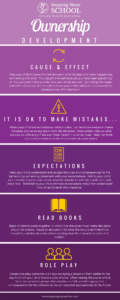5 Ways to Help Children Take Ownership of Their Behavior
My four-year-old is obsessed with connect-the-dot puzzles. Revealing the hidden shape after connecting each letter or number in sequential order brings him a special thrill
In life, helping children “connect the dots” or recognize the link between actions and results enable children to see the relationship between their choices and the consequences of their behavior.
This month, Stepping Stone School teachers will discuss the Kindness and Empathy™goal for the month: Ownership. Children will participate in discussions, learning activities, and read children’s literature demonstrating how to take ownership for their words and actions.
Here are some ideas to help develop this character trait at home:
- Help your child discover the link between what he does and what happens by “connecting the dots.” “You caught the ball because you have been practicing!” or “You jumped in the puddle, now your shoes are wet.” Identifying the cause and effect of various actions will increase your child’s ability to understand the consequences of his behavior.
- When your child makes mistakes, remain calm. Let her know everyone makes mistakes, but we always learn from the situation. Once settled, discuss what she can do differently if she ever finds herself in a similar state. Help her think and consider how to make the current situation better.
- Help your child understand and accept the rules and consequences for his behavior by remaining consistent with your expectations. Talk to your child prior to entering the store about what he should do with his hands, feet, and voice level. Reminding your child of these expectations helps him understand how to act in each circumstance.
- Read children’s books together in which the character must make decisions about her actions. Pause to ask your child what she should do if she finds herself in a similar situation before reading how the character resolves the matter.
- Create role-play scenarios with toys replaying a situation from earlier in the day in which your child made a poor choice. Often seeing the scene unfold from an outsider’s perspective enables a child to better gauge the consequences for his behavior so he can respond appropriately in the future.

Over the course of this month, your child will learn to evaluate his choices, beginning to take ownership of his words and actions.
References:
Batema,C. “How to Help Children Manage Their Own Behavior.” Retrieved from http://everydaylife.globalpost.com/children-manage-own-behavior-1253.html
Raiford, T. “How to Get children to Take Responsibility for Their Actions”Retrieved from http://motherhood.modernmom.com/children-responsibility-actions-15668.html
Reece, T. “How to Teach Kids to Take Accept Responsibility for Their Actions”Retrieved from http://www.parents.com/kids/responsibility/values/its-not-my-fault/